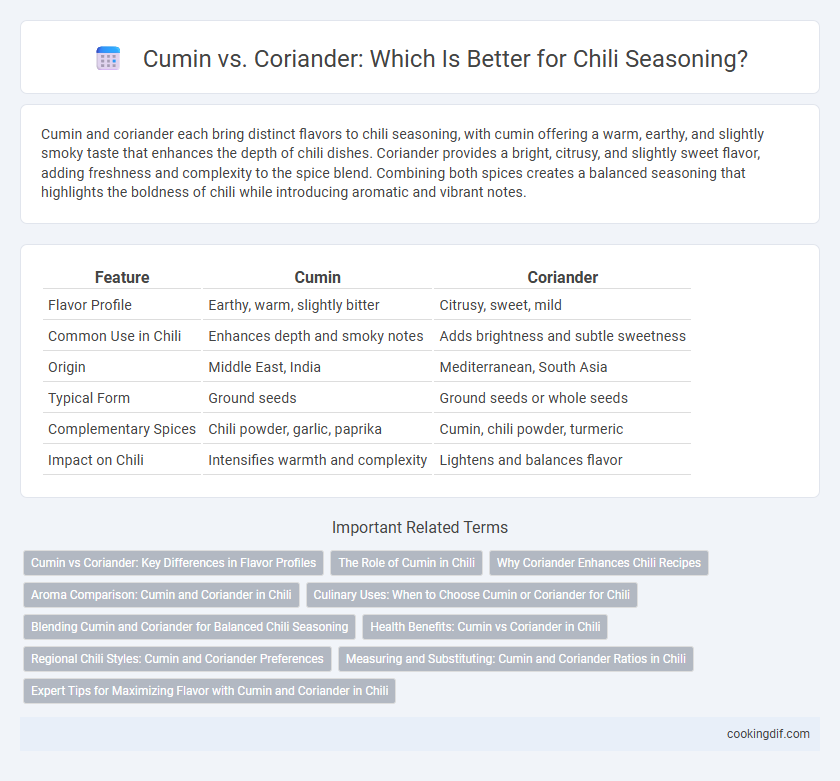Cumin and coriander each bring distinct flavors to chili seasoning, with cumin offering a warm, earthy, and slightly smoky taste that enhances the depth of chili dishes. Coriander provides a bright, citrusy, and slightly sweet flavor, adding freshness and complexity to the spice blend. Combining both spices creates a balanced seasoning that highlights the boldness of chili while introducing aromatic and vibrant notes.
Table of Comparison
| Feature | Cumin | Coriander |
|---|---|---|
| Flavor Profile | Earthy, warm, slightly bitter | Citrusy, sweet, mild |
| Common Use in Chili | Enhances depth and smoky notes | Adds brightness and subtle sweetness |
| Origin | Middle East, India | Mediterranean, South Asia |
| Typical Form | Ground seeds | Ground seeds or whole seeds |
| Complementary Spices | Chili powder, garlic, paprika | Cumin, chili powder, turmeric |
| Impact on Chili | Intensifies warmth and complexity | Lightens and balances flavor |
Cumin vs Coriander: Key Differences in Flavor Profiles
Cumin and coriander offer distinct flavor profiles that enhance chili seasoning in unique ways. Cumin provides a warm, earthy, and slightly smoky taste with a hint of bitterness, making it essential for depth and intensity in chili recipes. In contrast, coriander delivers a bright, citrusy, and slightly sweet flavor that adds freshness and balance to the rich, spicy elements in chili.
The Role of Cumin in Chili
Cumin plays a crucial role in chili seasoning by imparting a warm, earthy flavor that enhances the dish's depth and complexity. Unlike coriander, which brings a citrusy and slightly sweet note, cumin adds a robust, smoky undertone that complements chili's spicy and savory elements. This spice is essential for creating the traditional aromatic profile that defines authentic chili recipes.
Why Coriander Enhances Chili Recipes
Coriander enhances chili recipes by adding a citrusy, slightly sweet flavor that complements the spicy heat of chili peppers and the earthiness of cumin. Its fresh, bright notes balance the rich, smoky undertones, creating a more complex and layered taste profile. Incorporating ground coriander boosts the overall aroma and depth, making the chili seasoning more vibrant and flavorful.
Aroma Comparison: Cumin and Coriander in Chili
Cumin imparts a warm, earthy aroma with smoky undertones that deeply enhances chili's robust flavor profile, making it a staple in many chili recipes. Coriander offers a lighter, citrusy aroma with subtle floral notes, providing a refreshing contrast that brightens the overall scent. Combining cumin and coriander in chili seasoning creates a balanced aromatic experience, blending depth with brightness for a more complex sensory appeal.
Culinary Uses: When to Choose Cumin or Coriander for Chili
Cumin imparts a warm, earthy, and slightly bitter flavor that intensifies the depth of chili dishes, making it ideal for robust meat-based or smoky chili recipes. Coriander offers a fresh, citrusy, and slightly sweet taste that brightens chili, perfect for vegetable-heavy or lighter chili varieties. Choosing cumin enhances the spicy, hearty profile, while coriander adds a lively, aromatic balance to chili seasoning.
Blending Cumin and Coriander for Balanced Chili Seasoning
Blending cumin and coriander creates a balanced chili seasoning by combining cumin's warm, earthy notes with coriander's bright, citrusy undertones. This duo enhances the depth of chili flavors, complementing smoky chili peppers and rich tomato bases. Using a ratio of two parts cumin to one part coriander often achieves an ideal harmony in Mexican and Southwestern chili recipes.
Health Benefits: Cumin vs Coriander in Chili
Cumin is rich in antioxidants and has anti-inflammatory properties that support digestion and boost immunity, making it a valuable addition to chili seasoning. Coriander offers digestive benefits as well, with its high levels of dietary fiber, vitamins C and K, and essential minerals like potassium, which contribute to heart health and blood sugar regulation. Both spices enhance chili's flavor profile while providing complementary health advantages, with cumin primarily aiding metabolic function and coriander promoting detoxification.
Regional Chili Styles: Cumin and Coriander Preferences
In regional chili styles, cumin dominates as a key seasoning in Southwestern and Tex-Mex chili recipes, lending a warm, earthy, and slightly smoky flavor essential to authentic dishes. Coriander finds greater use in Mexican and some Central American chili varieties, where its citrusy and floral notes complement the heat and complexity of local peppers. Understanding these spice preferences enhances the distinct regional flavor profiles and cultural authenticity of chili preparations.
Measuring and Substituting: Cumin and Coriander Ratios in Chili
When measuring cumin and coriander for chili seasoning, a standard ratio is 1:1 to maintain balanced flavor, typically using one teaspoon of each per pot of chili. Substituting cumin with coriander should be done cautiously, as coriander has a lighter, citrusy note compared to cumin's earthy, warm profile, so reduce coriander to half the amount when replacing cumin to avoid overpowering the dish. Adjusting these ratios fine-tunes the chili's aromatic complexity, enhancing its depth without overwhelming the palate.
Expert Tips for Maximizing Flavor with Cumin and Coriander in Chili
Cumin's earthy and smoky notes intensify chili's depth, while coriander contributes a citrusy brightness that balances richness. Use toasted cumin seeds ground fresh to release essential oils, enhancing aroma and flavor complexity. Pair ground coriander in moderate amounts to avoid overpowering chili's base spices, creating a harmonious flavor profile tailored for authentic chili seasoning.
Cumin vs coriander for chili seasoning Infographic

 cookingdif.com
cookingdif.com